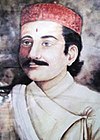Bahun
Bahun (Khas Brahmin) (Nepali: बाहुन) are group of people belonging to Brahmin caste in Khas group, an Indo-Aryan ethno-linguistic group. Generally, the Parvate/Pahari (hilly) Brahmins are called as Bahuns or Khas Bahuns. They are Sub caste of the Kanyakubja Brahmin.[1][2][3] Bahuns mainly served as priests, teachers and astrologers as per their caste. Bahuns were able to hold government offices, administration and politics.
बाहुन (पहाडी ब्राह्मण/नेपाली ब्राह्मण) Bāhuna (pahāḍī brāhmaṇa/nēpālī brāhmaṇa) | |
|---|---|
Top: Ranganath Paudyal · Bhanubhakta Acharya · Lekhnath Paudyal Bottom: BP Koirala · Sugam Pokharel · Manisha Koirala | |
| Total population | |
| 32 lakhs (12.2% of Nepal), as per Nepal Census 2011 | |
| Regions with significant populations | |
| Languages | |
| Nepali language (Khas Kura) as mother tongue | |
| Religion | |
| Hinduism (99% approx.) with ancestral deity worship | |
| Related ethnic groups | |
| Brahmin, Khas, Garhwali, Kshetri, Thakuri |

According to 1854 Muluki Ain (Legal Code) of Nepal, Bahuns belong to sacred thread bearers (Yagyopavit) and twice born (Dvija) Hindus.[4]
Khas Bahun family names
changeAcharya, Adhikari, Amgain/Apagain, Aryal/Arjyel, Awasthi, Baagh, Badu, Banjara, Bajgain, Banjade, Banskota, Banstola, Baral, Bartaula, Bastakoti, Brahmin Bhandari(not to be mistaken from Chhetri Bhandari), Bhatta, Bhattarai, Binadi, Bhurtel, Bhusal, Bist, Bohora, Burlakoti, Chalise, Chataut, Chapagain, Chaugain, Chaulagain, Dangal, Dahal, Dawadi/Duwadi, Devkota, Dhakal, Dhital, Dhungana, Dhungel, Dixit, Dulal, Gaire, Gautam, Ghimire, Ghorasaini, Guragain, Gyawali, Humagain, Jamarkattel, Joshi, Kafle, Kalauni, Kapadi, Kattel, Khanal, Khaniya, Kharel/Kharal, Kuikel, Khatiwada, Koirala, Lamichhane, Lamsal, Lekhak, Lohani, Luintel, Mainali, Marasini, Mishra, Mudbhari, Nepal, Neupane, Niroula, Ojha, Oli, Padhya, Paitola, Pandey, Pandit, Paneru, Panta, Parajuli, Pathak, Phuyal, Pokharel/Pokhrel, Poudel/Paudyal/Poudar(hill), Prasain, Pudasaini, Pyakurel, Rijal, Rimal, Risal, Regmi, Rupakheti, Sanjel, Sangroula, Sapkota, Sedhain, Sharma, Shiwakoti, Sigdel, Sitoula, Silwal, Subedi, Thapaliya, Timsina/Timalsina/Timilsina, Tiwari, Tripathi, Trital, Upadhyaya, Upreti, Wagle, Wasti/Osti etc
References
change- ↑ Declan Quigley, David Gellner (2017). Contested Hierarchies: A Collaborative Ethnography of Caste Among the Newars of Kathmandu. edited by David Gellner & Declan Quigley. Macmillan and Company limited. p. 199.
- ↑ Chaturvedi, Shyam lal (1945). In Fraternity with Nepal, An Account of the Activities Under the Auspices of the Wider Life Movement for the Furtherance and Consolidation of the Indo-Nepalese Cultural Fellowship. p. 65.
- ↑ Hachhethu, Krishna (2023). Nation-Building and Federalism in Nepal. p. 40.
- ↑ Serchan, Sanjaya (2001). Democracy, Pluralism and Change. ISBN 978-99933-54-39-0.





